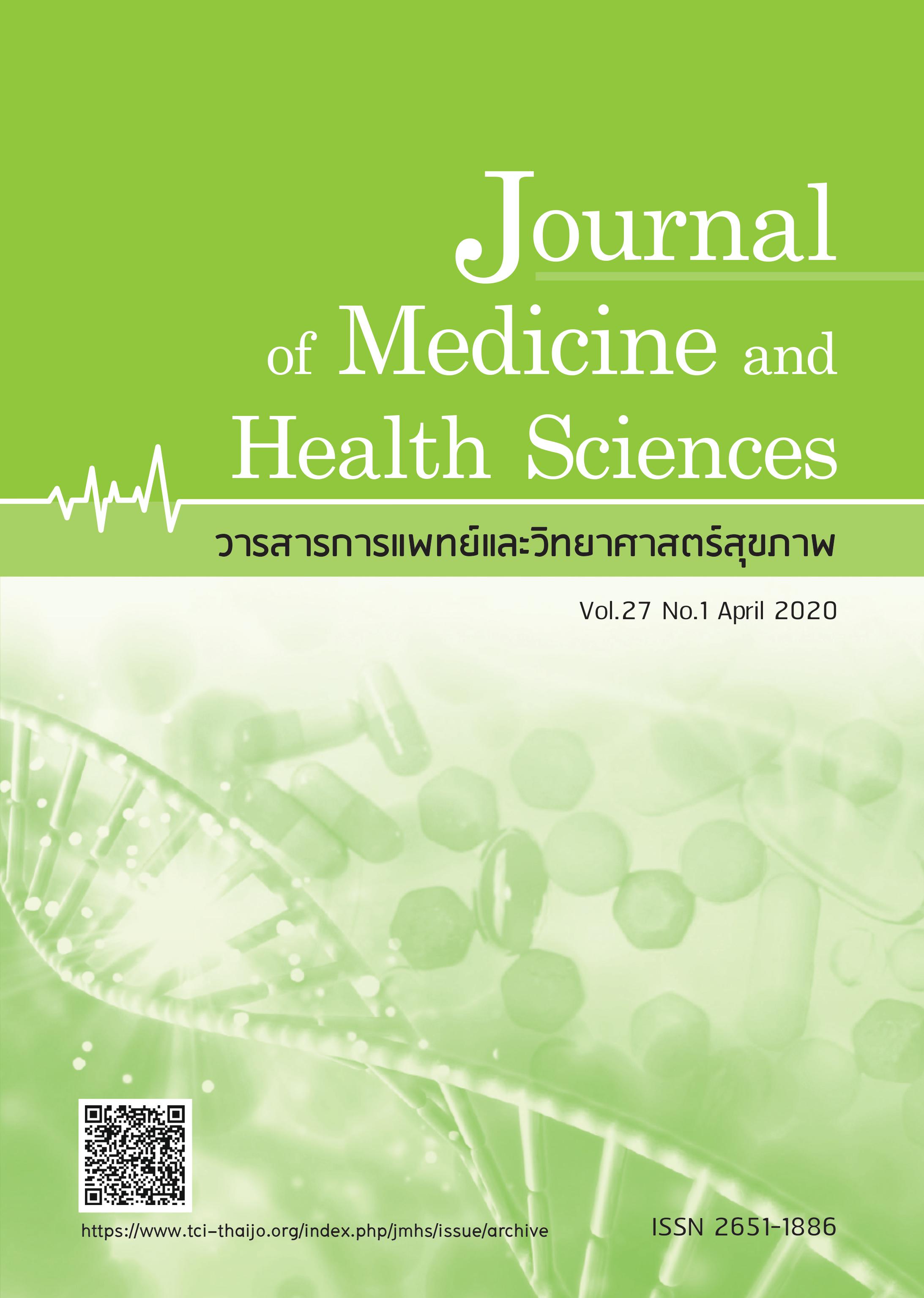Herbal formula used for menstrual disorders: case study of folk healers in Nakhon Si Thammarat, Phatthalung and Trang province
Keywords:
menstrual disorders, herbal formula, folk healersAbstract
บทคัดย่อ
การศึกษาครั้งนี้มีวัตถุประสงค์เพื่อศึกษาตำรับยาสมุนไพรรักษาโรคโลหิตระดูสตรี กรณีศึกษาหมอพื้นบ้านในจังหวัดนครศรีธรรมราช พัทลุง และตรัง โดยใช้แบบสอบถามกึ่งโครงสร้าง สัมภาษณ์หมอพื้นบ้านจำนวน 3 คน ผลการศึกษาในครั้งนี้ได้รวบรวมตำรับยารักษาโรคโลหิตระดูสตรีได้ทั้งหมด 13 ตำรับ ซึ่งเป็นตำรับยาที่หมอพื้นบ้านยังใช้รักษาผู้ป่วย แบ่งตำรับยาเป็น 4 กลุ่มอาการ ได้แก่ ประจำเดือนขาดปวดประจำเดือน ตกขาวผิดปกติ และวัยทอง มีตำรับยารักษาประจำเดือนขาดมากที่สุด 5 ตำรับ รองลงมาคือปวดประจำเดือน 4 ตำรับ วิธีปรุงยามี 3 วิธี วิธีที่นิยมใช้มากที่สุดคือ การต้มน้ำดื่ม 8 ตำรับ สำหรับสมุนไพรที่เป็นส่วนประกอบในตำรับยามีทั้งหมด 88 ชนิด จัดเป็นพืชวัตถุมากที่สุดจำนวน 83 ชนิด พืชสมุนไพรที่มีค่าการใช้มากที่สุดคือ ขิง รองลงมาคือ ขมิ้นอ้อย และจันทน์เทศ จากการศึกษาแสดงให้เห็นว่าหมอพื้นบ้านยังคงมีบทบาทสำคัญในการรักษาโรคโลหิตระดูสตรี
Abstract
The objective of this study was to study herbal formulas for menstrual disorders: case study of folk healers in Nakhon Si Thammarat, Phatthalung and Trang provinces by using a semi-structured questionnaire. The interview was conducted with 3 folk healers. Results showed that the folk healers for all 13 herbal formulas in 4 groups of menstrual disorders such as amenorrhea, dysmenorrhea, leucorrhea and menopause. 5 formulas of medicine for amenorrhea treatment are the most commonly prescribed, followed by 4 formulas for dysmenorrhea treatment. There are 3 methods of preparing the medicine. The most popular method is boiling with water for 8 formulas. In the formulas, there are 88 species of herbal ingredients, which are classified as the 83 medicinal plants. The most used medicinal plants are Zingiber officianle Roscoe, followed by Curcuma zedoaria (Christm.), Roscoe, and Myristica fragrans Houtt. This study shows that traditional healers continue to play an important role in the treatment of menstrual disorders.
References
2. Srisawat S, Sukchan P, Pradabsang C, et al. Local herbal and wisdom of application in Thai traditional medicine,bordering provinces of Southern Thailand.Princess of Naradhiwas University Journal 2013;(Suppl 1):14-27.
3. Mumanajit W, Nuim B. Restoration and Inheritance Thai traditional medical knowledge and indigenous medicine in Chon Buri Province. JHUSOC 2016;24(16):27:54.
4. Tem Smitinand’s Thai Plant Names. (Online). Available from: https://www.dnp.go.th/botany/mplant/index.aspx.
5. Ojewole JA. Analgesic, antiinflammatory and hypoglycaemic effects of ethanol extract of Zingiber officinale (Roscoe) rhizomes (Zingiberaceae) in mice and rats.Phytother Res 2006 Sep;20(9):764-72.
6. Maneenoon K, Chatawatee B, Damkhong C, et al. Kunworarath N. Knowledge of traditional healers on utilization of medicinal plants used for menstrual disorders in Krabi and Songkhla Provinces,Thailand. Burapha Sci J 2017;22(3):243-58.
7. Ullah HA, Zaman S, Juhara F, et al.Evaluation of antinociceptive, in-vivo &in-vitro anti-inflammatory activity of ethanolic extract of Curcuma zedoaria rhizome. BMC Complement Altern Med 2014;14(1):346.
8. A s g a r p a n a h J , K a z e m i v a s h N .Phytochemistry and pharmacologic properties of Myristica fragrans Hoyutt.:A review. AJB 2012;11(65):12787-93.
9. Tasleem F, Azhar I, Ali SN, et al. Analgesic and anti-inflammatory activities of Piper nigrum L. Asian Pac J Trop Med 2014;7:461-8.
10. Gandomani MZ, Molaali EF, Gandomani ZZ, et al. Evaluation of anti-inflammatory effect of hydroalcoholic extract of mangrove (Avicennia Marina) leaves in male rats. Medical Journal of Tabriz University of Medical Sciences & Health Services 2012;34(4):80-5.
11. Yang MH, Ali Z, Khan IA, et al. Antiinflammatory activity of constituents isolated from Terminalia chebula. Nat Prod Commun 2014;9(7):965-8.
12. Yin H, Luo JG, Kong LY. Diarylheptanoids from the fruits of Amomum kravanh and their inhibitory activities of nitric oxide production. Phytochemistry letters 2013;6(3):403-6.
13. Tanko Y, Mohammed A, Okasha MA, et al. Anti-nociceptive and anti-inflammatory activities of ethanol extract of Syzygium aromaticum flower bud in wistar rats and mice. Afr J Tradit Complement Altern Med 2008;22;5(2):209-12.
14. Saneja A, Kaushik P, Kaushik D, et al. Antioxidant, analgesic and antiinflammatory activities of Santalum album Linn. Planta Med 2009;75(4):452-3.
15. Reanmongkol W, Subhadhirasakul S,Bouking P. Antinociceptive and antipyretic activities of extracts and fractions from Dracaena loureiri in experimental animals. Songklanakarin J Sci Technol 2003;25(4):467-76.
16. Raju R, Sunny A, Thomas JK, et al. Isolation, characterization and in-vitro anti-inflammatory activity of Plumbago indica Linn. Adv Pharmacol Toxicol 2014;15(1):13-7.
17. Kumar A, Panghal S, Mallapur SS, et al. Anti-inflammatory activity of Piper longum fruit oil. Indian J Pharm Sci 2009;71(4):454-6.
18. Zakaria ZA, Patahuddin H, Mohamad AS, et al. In vivo anti-nociceptive and anti-inflammatory activities of the aqueous extract of the leaves of Piper sarmentosum. J Ethnopharmacol 2010; 128(1):42-8.
19. Sireeratawong S, Itharat A, Lerdvuthisopon N, et al. Anti-Inflammatory, Analgesic,and Antipyretic Activities of the Ethanol Extract of Piper interruptum Opiz. and Piper chaba Linn. ISRN Pharmacol 2012;18:1-6.
20. Al-Ghamdi MS. The anti-inflammatory,analgesic and antipyretic activity of Nigella sativa. J Ethnopharmacol 2001;76(1):45-8.
21. Aqel M, Shaheen R. Effects of the volatile oil of Nigella sativa seeds on the uterine smooth muscle of rat and guinea pig. J Ethnopharmacol 1996;52(1):23-6.
22. Raval ND, Ravishankar B, Ashok BK. Antiinflammatory effect of Chandrashura (Lepidium sativum Linn.) an experimental study. Ayu 2013;34(3):302-4.
23. Raval ND, Ravishankar B. Analgesic effect of Lepidium sativum Linn. (Chandrashura) in experimental animals. Ayu 2010;31(3):371-3.
24. Bhat SP, Rizvi W, Kumar A. Effect of Cuminum cyminum L. seed extracts on pain and inflammation. J Nat Remed 2014;14(2):186-92.
25. Jayesh K, Karishma R, Vysakh A, et al. Terminalia bellirica (Gaertn.) Roxb fruit exerts anti-inflammatory effect via regulating arachidonic acid pathway and pro- inflammatory cytokines in lipopolysaccharide-induced RAW 264.7 macrophages. Inflammopharmacology 2018;28(1):265-74.
26. Chuntum K, Kamlangluea K, Thongsrisuk T, et al. The cultural treatment of wisdom folk healers at Nafai sub-district, Muang district, Chaiyaphum. RDIBRU 2017;11:149-56.
27. Wanset S, Onchomchant D. A study of medicinal plants utilization of folk healers: a case study of folk healers in Chiang Rai province Thailand. J Thai Trad Alt Med 2018;16(3):420-35.
28. Iam-am A, Thippayacharoentam T,Thippayacharoentam C, et al. Analytical study of herbal medicine in Phrom P’Rohit scripture. DRJ 2018;17(2):137-62.
29. Thai Language Institution, Academic Department, Mistry of Education. Phatsart Songkroa. Bangkok: Kurusapa Printing Ladphrao;2000;p.994.
30. Bureau of Sanatofium and Healing Arts.Thai Traditional medicine textbook 1998;21-53. (in Thai)
31. National Drug System Development Committee. National List of Essential Medicines, Drug List in Herbal Medicinal Products 2013. [Internet].2019. [Cited 5 June 2019]. Available from: https:// http://kpo.moph.go.th/webkpo/tool/Thaimed2555.pdf.
32. Pranakhon R, Sanklong C, Suwongtha S, et al. Follow-up affecting the used of herbal medicine “Saow Song Pun Pee” treatment on symptoms during menstruation. HCU J Health Sci 2017;19(38):13-19.



